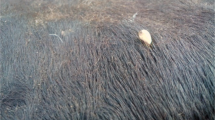Abstract
Hypodermosis is one of the important veterinary problems because of its worldwide prevalence and significant economic losses. Economic losses is due to decreasing of productivity potential and leather quality. The disease is caused by two parasitic fly species in cattle, Hypoderma bovis and lineatus. Diagnosis of the parasites has crucial importance because of treatment and eradication plannings. Basically diagnosis is based on parasitological methods but recently serological methods were used in some countries. In the present study, a total of 3716 cattle were investigated in Industrial Slaughter house of Ardebil, Northwest of Iran. In this study, the prevalence of H. lineatus and H. bovis was 0.32 % (12 larva) and 1.07 % (40 larva), respectively. Low prevalence of hypodermosis could be caused by cold climate of studied region also shows efficacy of controlling programs. Unlike low prevalence of Hypoderma spp. in the studied regions, antiparasitic agents such as organophosphates and avermectins should be used to reduce the prevalence.

Similar content being viewed by others
References
Argente G, Vaillant J, Boulard C (1998) Methods of evaluating a warble population in a warble cleaned area. Improvements in the control methods for warble fly in livestock. COST 811:68–70
Beesley W (1974) Economics and progress of warble fly eradication in Britain. Vet med rev 4:334–347
Catts E, Mullen G (2002) Myiasis (Muscoidea, Oestroidea). In: Mullen GR, Durden LA (eds) Medical and veterinary entomology, pp 318–348
Foreyt WJ (2013) Veterinary parasitology reference manual. Wiley, New York
Guan G, Luo J, Ma M, Yang D, Wang Y, Gao J, Sun H, Liu Z, Liu A, Dang Z (2005) Sero-epidemiological surveillance of hypodermosis in yaks and cattle in north China by ELISA. Vet Parasitol 129(1):133–137
Karatepe M, Karatepe B (2008) Hypodermosis in cattle slaughtered in Nigde province, Turkey*. Trop Anim Health Prod 40(6):383–386
Khan M, Iqbal Z, Khan I, Chaudhry S, Sajid M (2008) Surveillance of cattle hypodermosis in district Chakwal, Pakistan. Int J Agric Biol 10(3):337–339
Lamei R, Gharagozlou M, Amniattalab A (2012) Topographic survey on hypodermosis in slaughtered cows in Urmia Slaughterhouse. Vet J 93:8–12
Marquardt WC, Demaree RS, Grieve RB (2000) Parasitology and vector biology. 2nd edn. Harcourt Academic Press, London
Mullen GR, Durden LA (2002) Medical and veterinary entomology. Academic Press, London
Need JT, Butler JF (1991) Possible applications of the immune response of laboratory mice to the feeding of argasid ticks. J Med Entomol 28(2):250–253
Ogg J (1977) Eradication of Hypoderma species in Northern Ireland. Vet Parasitol 3(3):229–237
Otranto D, Testini G, Sottili R, Capelli G, Puccini V (2001) Screening of commercial milk samples using ELISA for immuno-epidemiological evidence of infection by the cattle grub (Diptera: Oestridae). Vet Parasitol 99(3):241–248
Piekarski G (1989) Medical parasitology. Springer, Berlin
Preston J (1984) Avermectins: new molecules for use in warble fly control. In: Boulard C, Thornberry H (eds) Warble fly control in Europe: a symposium in the EC Programme of Coordination of Research on Animal Pathology, Brussels, 16–17 September 1982, AA Balkema, Rotterdam, 1984
Rak H, Anwari M (1974) Some diptera larvae causing myiasis in Iran. Entomol Mon Mag 110:78–79
Sinclair I (1995) The reappearance of warble fly in Britain, 1993–1994. State Vet J 5(1):9–10
Soulsby EJL (1982) Helminths, arthropods and protozoa of domesticated animals. Bailliere Tindall, London
Taghipour Bazargani T, Baghban F, Rahbari S (2010) A survay of infestation with Hypoderma and affection to Hypodermosis of cattle and goats slauthered in Isfahan abattoir. Iran J Vet Clin Sci 3(2):3–13 (in Persian)
Zumpt F (1965) Myiasis in man and animals in the old world. A textbook for physicians, veterinarians and zoologists. Myiasis in man and animals in the old world. A textbook for physicians, veterinarians and zoologists. Butterworths, p 267
Acknowledgments
The authors gratefully acknowledge the parasitology department of veterinary faculty of Islamic Azad University, Science and Research Branch of Tehran, Iran to providing facilities and cooperation of slaughtered-house of Ardebil in samples collection.
Author information
Authors and Affiliations
Corresponding author
Rights and permissions
About this article
Cite this article
Bagherzadeh, N.M., Behniafar, H., Rahbari, S. et al. Prevalence of hypodermosis in cattle slaughtered in industrial slaughtered-house of Ardebil, Iran. J Parasit Dis 40, 1579–1582 (2016). https://doi.org/10.1007/s12639-015-0733-6
Received:
Accepted:
Published:
Issue Date:
DOI: https://doi.org/10.1007/s12639-015-0733-6




